

Asynchronous programming. Python3.5+ - Blog. This is the fourth post in a series on asynchronous programming.
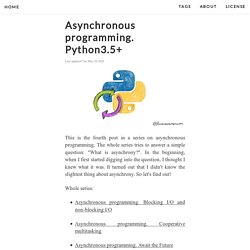
The whole series tries to answer a simple question: "What is asynchrony? ". In the beginning, when I first started digging into the question, I thought I knew what it was. It turned out that I didn't know the slightest thing about asynchrony. So let's find out! Python concurrency: asyncio for threading users. Photo by Adrian Schwarz You’ve probably heard this classic software engineering mantra: Concurrency is hard.

The undeniable fact is that an entire category of software bugs, known for being elusive and frustrating to reproduce, is gated behind the introduction of concurrency to a project. Race conditions, mutual exclusion, deadlock, and starvation, to name a few. Most programming languages with concurrency features ship with some or all of the classical concurrency primitives: threads, locks, events, semaphores, mutexes, thread-safe queues, and so on. Asyncio Synchronization Primitives Tutorial - Queues and Locks.
This tutorial was built on top of Python 3.6 Video Tutorial In this tutorial we’ll be looking at the various synchronization primitives available to you in your Asyncio programming adventures.

We’ll be taking a brief look at why these synchronization primitives are important and also the various ways you can use them within a simple Asyncio based program. Why Are These Important? Passing Messages to Processes — PyMOTW 3. As with threads, a common use pattern for multiple processes is to divide a job up among several workers to run in parallel.
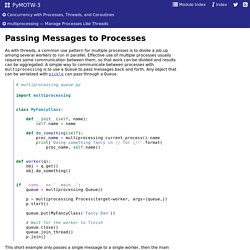
Effective use of multiple processes usually requires some communication between them, so that work can be divided and results can be aggregated. Gevent Tutorial. The structure of this tutorial assumes an intermediate level knowledge of Python but not much else.
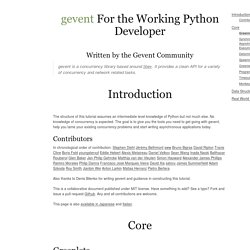
No knowledge of concurrency is expected. The goal is to give you the tools you need to get going with gevent, help you tame your existing concurrency problems and start writing asynchronous applications today. Contributors In chronological order of contribution: Stephen DiehlJérémy BethmontswwBruno BigrasDavid RiptonTravis ClineBoris FeldyoungsterxyfEddie HebertAlexis MetaireauDaniel VelkovSean WangInada NaokiBalthazar RouberolGlen BakerJan-Philip GehrckeMatthijs van der VleutenSimon HaywardAlexander James PhillipsRamiro MoralesPhilip DamraFrancisco José Marques VieiraDavid XiasatoruJames SummerfieldAdam SzkodaRoy SmithJianbin WeiAnton LarkinMatias HerranzPietro Bertera Also thanks to Denis Bilenko for writing gevent and guidance in constructing this tutorial.
Python API Reference — greenlet 1.0.1.dev0 documentation. Plongée au cœur de l'asynchrone en Python. Async IO in Python: A Complete Walkthrough. Async IO is a concurrent programming design that has received dedicated support in Python, evolving rapidly from Python 3.4 through 3.7, and probably beyond.

You may be thinking with dread, “Concurrency, parallelism, threading, multiprocessing. That’s a lot to grasp already. Where does async IO fit in?” Async IO in Python: A Complete Walkthrough. Plongée au cœur de l'asynchrone en Python. TomMoral/loky: Robust and reusable Executor for joblib. Development — joblib 1.1.0.dev0 documentation. Workflow to contribute To contribute to joblib, first create an account on github.

Once this is done, fork the joblib repository to have your own repository, clone it using ‘git clone’ on the computers where you want to work. Make your changes in your clone, push them to your github account, test them on several computers, and when you are happy with them, send a pull request to the main repository. Latest changes. Modern Parallel and Distributed Python: A Quick Tutorial on Ray. The ray.init() command starts all of the relevant Ray processes.
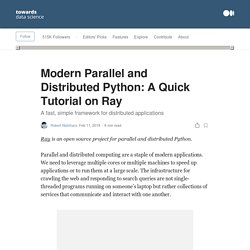
On a cluster, this is the only line that needs to change (we need to pass in the cluster address). These processes include the following: A number of worker processes for executing Python functions in parallel (roughly one worker per CPU core).A scheduler process for assigning “tasks” to workers (and to other machines). A task is the unit of work scheduled by Ray and corresponds to one function invocation or method invocation.A shared-memory object store for sharing objects efficiently between workers (without creating copies).An in-memory database for storing metadata needed to rerun tasks in the event of machine failures. Introduction à la programmation Parallèle et Concurrente en Python. MagicStack/uvloop: Ultra fast asyncio event loop. Embarrassingly parallel for loops — joblib 0.14.1.dev0 documentation. Common usage.
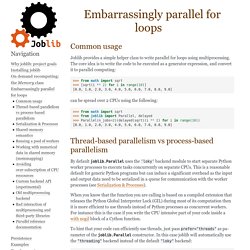
Vayel/introduction_systeme_distribues: Code source pour. Introduction aux systèmes distribués. Afin de tester ma connexion Internet, j’ai pour habitude d’exécuter la commande ping google.com.

Basiquement, je demande au moteur de recherche s’il reçoit mes messages et, s’il ne me répond pas, je considère que je n’ai pas accès à Internet. Pourtant, il se pourrait que ce soit Google le problème et non le réseau. Tu plaisantes : un service indisponible chez Google ? Effectivement, c’est plutôt improbable. Et la raison à cela est que leur architecture repose sur un monstrueux système distribué. Une autre raison de connecter des machines et de les faire se coordonner est le calcul réparti.
Pour pallier tout ça, on fait appel au parallélisme : on découpe les calculs en petits morceaux les plus indépendants possibles puis on fait exécuter ces opérations par des composants pouvant travailler en même temps. Il nous faut alors disposer de plusieurs unités de calcul, que ce soit les cœurs d’un processeur, plusieurs processeurs sur une seule machine ou plusieurs machines en réseau. Pré-requis. Python threads synchronization: Locks, RLocks, Semaphores, Conditions and Queues. February 5, 2011 This article describes the Python threading synchronization mechanisms in details.
We are going to study the following types: Lock, RLock, Semaphore, Condition and Queue. Echanges E/S asynchrones avec Python 3. Communication Between Processes. As with threads, a common use pattern for multiple processes is to divide a job up among several workers to run in parallel. Effective use of multiple processes usually requires some communication between them, so that work can be divided and results can be aggregated. Passing Messages to Processes. Python Language - Travailler autour du verrou d'interprète global (GIL)
Le GIL existe dans CPython depuis la création des threads Python, en 1992. Il est conçu pour garantir la sécurité des threads lors de l’exécution du code python. Multiprocessing: How do I share a dict among multiple processes?